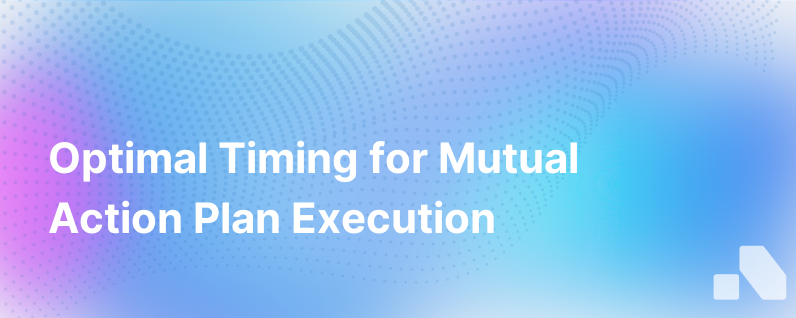
The Mutual Action Plan (MAP) is a pivotal tool in the complex dance of enterprise sales. It constitutes a clear and mutually agreed-upon document or set of steps designed to shepherd the prospect and the seller towards a successful deal closure. In the high-stakes B2B world, where the journey through the sales pipeline can be labyrinthine, a MAP is the Ariadne's thread that guides both parties through to a completed deal. It establishes checkpoints, assigns responsibilities, and sets expectations transparently.
The MAP: A Guiding Star for Complex Sales Cycles
Crafting and sharing a Mutual Action Plan is a delicate art in the realm of enterprise sales. Knowing when to share it with a potential customer can mean the difference between fostering a thriving partnership and frightening a prospect away with premature commitments. From the first encounter to the final handshake, timing is everything.
The Genesis of a MAP
The optimum moment to introduce a MAP varies, but it is firmly rooted in the establishment of trust. Before unveiling a MAP, rapport should be established, needs should be understood, and a preliminary nod to your solution's fit should be given. This generally happens at the conclusion of the discovery phase, when both parties have a clear understanding of the objectives and challenges at hand and are beginning to contemplate how they might solve them together.
The Advantages of Early Sharing
-
Alignment From the Outset: Introducing a MAP post-discovery allows you to align on the process early, setting the stage for a cooperative journey. Mutual understanding of the timeline, major milestones, and expected outcomes helps avoid misalignments and sets a foundation for collaborative problem-solving.
-
Building Trust: A well-architected MAP can solidify your position as a trusted advisor. It demonstrates foresight, organization, and respect for the prospect's needs and timelines.
-
Acceleration of the Sales Process: Prospects appreciate efficiency. A MAP counters inertia by clearly outlining the next steps, decision points, and dependencies, keeping the momentum alive.
-
Identification of Roadblocks: Early sharing can help bring potential obstacles to light before they become deal-breakers, allowing both sides to strategize on preventative measures and contingencies.
The Prelude to Proposal
A MAP should precede the proposal or quote by a significant margin. It should be an integral part of the conversation long before specific pricing, scopes, or contracts are discussed. This allows for the absorption of complex information, stakeholder buy-in, and negotiation of the particulars of the MAP itself.
Customization Is Key
Remember that no two deals are identical. Tailoring the MAP to the unique situation, culture, and sales stage of each prospect is essential. Early-stage startups presenting a MAP may opt for a high-level approach, while established companies might dive into granular details.
Crafting a Stellar MAP
A Mutual Action Plan should be a carefully customized tool that guides your potential customer through the buying journey. Here are the scaffolds upon which your MAP should be built:
-
A Tailored Timeline: Your MAP should include a detailed timeline of events leading up to the close of the deal, including implementation and post-sale support.
-
Clearly Defined Steps: Outline what needs to be accomplished at each stage, with specific action items assigned to both the seller and buyer.
-
Milestones and Checkpoints: Identify the gates or approval points critical in the buying process, and agree on how to approach them.
-
Dependencies and Responsibilities: Clearly state who needs to do what and when to steer clear of confusion and hold both parties accountable.
-
Risk Mitigation: Address potential risks, and have a conversation around how they might be mitigated or managed.
-
Contingencies and 'Plan Bs': Lay out alternative routes in case agreed-upon steps face unexpected challenges.
Best Practices in Sharing Your MAP
As you prepare to share your Mutual Action Plan, here are some strategies to ensure it's well-received and effective:
-
Collaborate, Don’t Dictate: Treat your MAP as a collaborative draft, not a dictum. Encourage feedback, and be flexible with adjustments, acknowledging that it's a shared journey.
-
Visualization and Simplification: Where possible, visualize the MAP using Gantt charts, roadmaps, or project management tools to simplify complex processes.
-
Iterate and Evolve: Understand that the MAP is not set in stone. As circumstances change, be prepared to iterate on the plan with your prospect.
-
Communicate Value Continuously: Each step in your MAP should clearly articulate the value to the prospect, reinforcing why they’re on this journey with you.
-
Use Technology Wisely: Leveraging sales enablement platforms can make MAPs interactive and more digestible, fostering deeper engagement with the prospect.
Closing with Consideration
A MAP is not just a checkbox exercise or a purely operational tool; it signifies a partnership, a mutual commitment to achieving a set of goals. It's an end-to-end conceptualization that transcends mere transactional exchange and transforms a potential customer interaction into a partnership journey. Shared too late, it loses its potency; shared too early, it can overwhelm.
As a solution at the forefront of B2B sales strategy, Aomni understands the importance of timing in sharing a Mutual Action Plan. A well-designed, considerately-shared MAP is not just a document; it's a promise of an efficient, transparent, and guided path to a fruitful partnership.
Aomni helps sellers create these intelligent roadmaps for success, charting out the course of the buyer-seller relationship with skill, nurturing trust, and ultimately bringing about a win-win culmination. With a keen understanding of the rhythm of sales, we extend our platform to help you determine and execute the ideal MAP-sharing strategy for every unique enterprise deal.